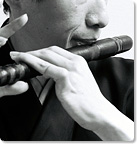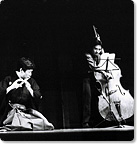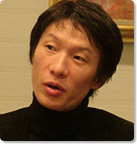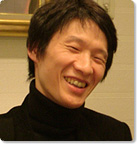- In Japan’s traditional arts there is accustom of having a child begin training in his art on the sixth day of the sixth month of his sixth year [because of the auspicious implications of the number six] in hopes that he will make good progress in his training. At what age did you begin training on the flute?
- It was at eight or nine, anyway, I know I was past the age of seven. The flute is played by covering the finger holes with the fingers and the child has to have hands big enough to reach the holes before he can begin studying. At the age of seven the hand is still too small to reach and cover the finger holes.
- You were born into a family of Noh flutists (hayashi-kata fue-kata). Does the eldest son always carry on the family tradition in such a family?
-
Yes. Most are expected to and do. In my case, I was never told by my father that my lessons would begin when I reached a certain age, but somehow I found myself naturally starting to play the flute. The reason is that my father was practicing every day and his students were coming for their lessons, so our house was always full of the sound of the flute. And there was always a flute within reach, so I naturally played with them from the time I was a little child and thought they were interesting and fun. I wondered how you could get a sound out of them, and I think I was the one who asked for my first lessons, saying, “Show me how you do it.”
Don’t you think this flute is an interesting instrument? It is just a piece of bamboo with a few holes in it, but if you have the right skills you can make it do almost anything. It produces a variety of different sounds and plays all kinds of melodies. So, that interest naturally developed and before I knew it I was learning how to play.
Though I seem to recall being taught how to hold the flute, I was never taught any actual technique. In Japanese traditional music there is no teaching method like they have in Western music. In my case you could say that I just learn by watching the movements of my father’s fingers. And, since there were flutes being played around me every day, I learned from an early age what good pitch and tone was.
The Noh flute is an instrument that takes a lot of breath to play. By adjusting the way you blow into the blow hole, the shape you cup your lips into and the angle you blow at, if you get just the right point you can get a large, good sound with less breath. I was the kind of precocious brat who would say, “That guy is wasting breath. Blowing like that is no good at all!” (Laughs). - There are a lot of plays in the Noh repertoire and a lot of music that has to be learned. Did you learn the repertoire just by ear?
-
There are about 250 pieces in the Noh repertoire and there are a number of variations in the hayashi (accompaniment) that may involve just one line being played differently, and there are also adjustments that have to be made when you are performing with people from a different school of Noh. So, you could say that the number of pieces in the Noh repertoire is uncountable. You listen to the different performances from backstage or while the musicians are practicing, and I am the type who can learn most of the pieces if I hear them once.
A Noh flutist is considered a professional if he masters performance of the four plays Dojoji, Shakkyo, Midare and Okina. I learned Midare from my father, but the others I learned by being told to come to the performances and watching from backstage. But, I was never taught the finger movements for making the decorative sounds known as sashiyubi.
Not only my father but all Noh flutists have their own sashiyubi technique and it is not something that is written in the music scores. It is something that you work out by yourself. When the sashiyubi comes in it makes the sound richer and it is really impressive. When I first began learning the flute I would try the sashiyubi and my father would say, “Stop that. When you are young you should play it straight without sashiyubi.” But I didn’t listen to him. They say that in terms of neural function, the human fingers peak at the age of 25. So, in order to master the delicate nuances of sound produced by finger movements, you have to be learning them from a young age. Otherwise the fingers just won’t move the way they need to. - I have had the opportunity to see a Noh flute being made, and it involves splitting the bamboo into a number of pieces and putting it back together with the hard outer surface on the inside and binding it with cherry bark or rattan. Seeing this, I thought that it must be this construction that makes it possible for the flute to produce the kind of hard-pitched sound that is used at critical moments in the play when the flute seems to be calling forth a spirit.
-
I also have wondered why they go to such effort to construct the flute in that way. And the Noh flute is not made from just one piece of bamboo. Between the blow hole and the seven finger holes there is a thin bamboo piece called the nodo (throat) that reduces the diameter of the flute tube. With the yokobue (horizontally held Japanese bamboo flute), you can raise the pitch of the sound one octave by blowing harder while keeping the same fingering, but because of the nodo piece in the Noh flute, you can’t raise the pitch an octave. What’s more, every Noh flute has a different pitch and can have a different sound depending on how it is played. The pitch is a relative thing; it is not strictly set like a Western flute.
It is often noted that Japanese traditional instruments don’t fit the Western “sol-fa” scale. The reason they don’t is because they don’t adopt a “tempered scale” like Western music. But there are plenty of ethnic instruments around the world that don’t adopt a tempered scale, and even most Baroque music is not played with a tempered scale. - Now that you have mentioned Baroque music, I would like to ask you about your other musical activities. You have taken on the challenge of playing Baroque music and rock music using the Japanese Noh flute and sinobue flute. You also compose music, too. When did you begin venturing out of the Noh tradition into new kinds of music?
-
The Noh flute is only played with what we call the shibyoshi , the ensemble consisting of the ookawa drum, the kotsuzumi drum and the taiko drum. When we learn to play the recorder in elementary school, it is an instrument that can be played in ensemble with a variety of instruments, such as the violin and harpsichord. So, I began to think it would be nice if the Noh flute could also be played with other instruments.
But, because the Noh flute does not have a tempered pitch and scale, you can’t make it fit exactly with the scale of the other instruments you are playing with. It is impossible if you confine yourself to the traditional technique. So, I decided that I should create my own scale. I found that by changing the way I put the lips to the flute and, taking a hint from recorder technique, I could adjust the way I used to the fingers enough to enable me to control the pitch sufficiently. Near the end of middle school I began to listen to jazz and rock, and I got the idea that I could use sashiyubi technique to adapt the sound of the Noh flute. I also got the desire to try playing the different flutes from around the world.
In high school friends and I formed a band with guitar, drums, bass, keyboard and my Noh flute, and we started playing at live-performance clubs. At the same time I was playing Baroque music like Bach and Telemann. I listened to a lot of different kinds of music and my interests broadened. In the process, I started to think about creating music of my own. I wanted to create music where the flute had the lead, so I started composing. I didn’t like the first piece I wrote, though. - In Japanese we use the expression “wearing two pairs of sandals” when a person is doing two different jobs that one person is not usually capable of. It seems to me that you have been wearing more than two pairs of sandals.
-
Not really. I think it is all the same pair of sandals. The famous flamenco guitarist Paco de Lucia was originally playing guitar to accompany flamenco dancers, but he also brought the guitar itself out on stage as a lead instrument. He has also done collaborations with musicians from other genre. I am trying to work in the same way Paco is. Without leaving the traditional Noh music behind, I want to play classical music and contemporary music too. That’s the way I see it. And, I believe that that is also how the traditions we think of “traditional” today were actually formed. At the time Noh was born, it was an avant-garde contemporary art.
The traditional Noh repertoire doesn’t even use 10% of the potential of the Noh flute, I believe. If I use the technique I have learned from trying to get a different temperament and scale out of the Noh flute in an actual Noh play, the presence of the flute becomes accentuated and overall Noh performance becomes richer and livelier. In fact I am doing a variety of new things in the traditional Noh performances. When I do too much, they say that I am going off in the direction of technical virtuosity. But, there is still a lot that I think I can do. - Don’t you get criticized when you spend too much time working outside the tradition?
-
My father was worried about that, it is true. He passed away in December 2004. Near the end he would hang the posters from my [outside] concerts in the studio, but as for whether he actually wanted to be supportive of my outside activities, it remains a mystery to me.
A few years ago there was a period of about a year and a half when my lips went numb and I couldn’t play the [horizontal] flute. I could play a recorder, because it is an instrument where you put the blow hole in your mouth, but with the [horizontal] flute you have to shape the breath with your lips as you blow into the blow hole in order to control the sound, so you can’t play it if your lips are numb. It just happened that at that time I was feeling rather confined in the Noh world, so I started thinking that if the numbness didn’t go away I would change to the vertical flute. But when my lips got better and I started performing in Noh again, I found so many people who were really happy to see me back performing in Noh again. That made me very grateful, and it made me realize what an important thing the Noh world really was for me. - After your recovery, however, your range of activities has only continued to expand. You are now the leader of several bands and you are also developing instruments.
- I get the feeling that a certain combination of instruments and the music possible with them is exactly right for what I want to do. In one case it may be my Noh flute with drums and electric guitar, in another case a guitar and tabla and Noh flute. When I get these revelations a band is formed and in the process I have come to the point where I am now playing with four different bands. If played by different performers and different instruments, the same piece of music will in fact become completely a piece. A lot of new discoveries are made. As for the reason I started making instruments, it was the desire I get for certain sounds when composing or performing. And it became possible to translate those desires into new instruments after I met the instrument maker Mr. Ranjo. After I wrote a piece that used only low notes, I had him make a “ryobue” flute. Ryo means the lower scale of notes in Japanese music. We also made a Noh flute without the nodo piece in order to make it easier to get the pitches I wanted. If you only do traditional Noh performances, one Noh flute or maybe two will last you your whole life. In my case, however, I will use different flutes for different Noh play, ones with a softer sound for some plays and ones with a harder sound for others. When I counted recently, I found that in all had about 500 flutes, including my recorders and tsunobue (oliphant).
- In other words, could you say that you have a different flute for every kind of music you want to play?
-
There is no limit to the things I want to do. Of course traditions like Noh are magnificent and complete creations in themselves, and I intend to continue perfecting my Noh performance. Within the shibyoshi ensemble of the Noh theater, if the flute is a horizontal line of music, the ookawa , kotsuzumi and taiko drums are points. With regard to how those points and the horizontal line interact, a lot of variation can be brought to play by the way the sashiyubi is used. There are always new discoveries in the traditional arts as well.
I am also thinking of creating new original Noh works. If you put a story into the Noh format, anything can become an original new Noh play. It is just like thinking up new words to an old song. For the music I am thinking of using the traditional shibyoshi ensemble, but I plan to make it different from anything that has been done so far in new Noh. I am a musician, so I can’t write a play. What I am thinking of doing is writing the original music and then getting someone to develop the story from there.
Outside of Noh, I think I would like to perform with Steve Vai, who used to play in Frank Zappa’s band. He is an amazing guitarist with incredible technique that he can use at will with protean creativity. I’d also like to play with John McLaughlin, too. I like the guitar and play it myself, but unlike the flute, the guitar has a suppressed sound. An electric guitar can extend the sound and produce weightier sound. Since there tends to be a lot of lively movement in my pieces, so I think it would be very interesting to play with a guitarist who can play with a good sense of speed. Just like there are no limits to the variations possible in improvisational performance, there is really no end to the things I want to do.
Yukihiro Isso
From the Noh stage to the contemporary music scene
Talking to innovator Yukihiro Isso
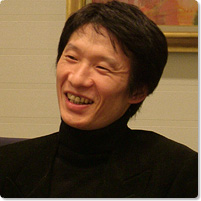
Yukihiro Isso
Born in 1964, Yukihiro Isso is a Noh hayashi-kata fue-kata flutist of the Isso school. He received his initial instruction in flute playing from his father Yukimasa Isso and performed on the Noh stage for the first time at the age of nine. From his middle school years he began to listen to a variety of different kinds of music and studying new instruments including the recorder, flute and piano. In addition to performing on the traditional Noh stage, he began performing with a number of bands from his high school years and expanded his genre to include rock and jazz and performed with a variety of musicians from Japan and abroad. Since 1991 he has led a band of performers in the “Ohiyari” concert series play in primarily pieces composed by himself. In February 2006 he will perform the premiere of his own composition “Suite Flute Fantasy” with a full orchestra.
Interviewer: Kazumi Narabe
